Home / Addition-Elimination Mechanisms With Neutral Nucleophiles (Including Acid Catalysis)
Carboxylic Acid Derivatives
Addition-Elimination Mechanisms With Neutral Nucleophiles (Including Acid Catalysis)
Last updated: May 22nd, 2023 |
The Second-Most Important Mechanism In Carbonyl Chemistry – Carbonyl Elimination
- The reverse of nucleophilic addition to the C=O bond (giving a tetrahedral intermediate) is elimination of a leaving group from the tetrahedral intermediate to re-form the C=O bond.
- This is called, “1,2-elimination” or sometimes just “elimination” and is a key mechanism of the carbonyl functional group.
- Confusingly, eliminations of alkyl halides are also called 1,2-eliminations. See The E2 Mechanism or E1cB or the E1 Reaction for more on these.)
- Eliminations are generally favored when expulsion of a leaving group results in formation of a weaker base
- Acid catalysis is extremely helpful in promoting nucleophilic acyl substitution of carboxylic acids and amides, since elimination results in the much better leaving groups H2O and NH3 (as opposed to O2- and (-)NH2 under basic conditions)
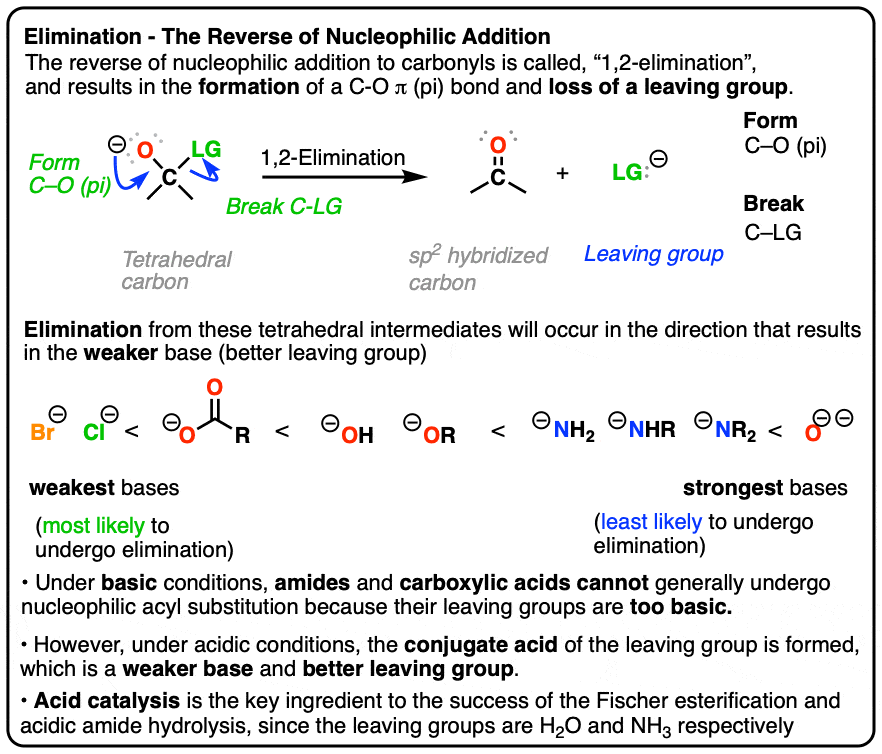
Table of Contents
- Elimination: The Second-Most Important Mechanism of the Carbonyl Group
- Elimination in Carboxylic Acid Derivatives
- What About Neutral Nucleophiles In Nucleophilic Acyl Substitution?
- Acid Catalysis For Nucleophilic Acyl Substitution With Neutral Nucleophiles
- Examples of Acid Catalysis
- Summary
- Notes
- Quiz Yourself!
- (Advanced) References and Further Reading
1. The Second-Most Important Mechanism Of The Carbonyl Group
Elimination (1,2-elimination) is an extremely important reaction mechanism of the carbonyl (C=O) group, which is present in such functional groups as aldehydes, ketones, carboxylic acids and carboxylic acid derivatives.

It’s the second most important reaction of carbonyls, after addition. In fact, it is the exact reverse of this nucleophilic addition reaction. (See post: Nucleophilic Addition)
For a reminder of the nucleophilic addition mechanism, hover here or click this link.
Elimination reactions tend to be favorable when the leaving group is a weaker base than the nucleophile. (See: What Makes A Good Leaving Group)
That’s why halide ions don’t successfully perform nucleophilic addition to aldehydes and ketones. The reaction is going uphill in terms of basicity. Since Cl(-) is a weaker base than O(-), elimination is much more favorable than addition. (See post: How to Use a pKa Table)
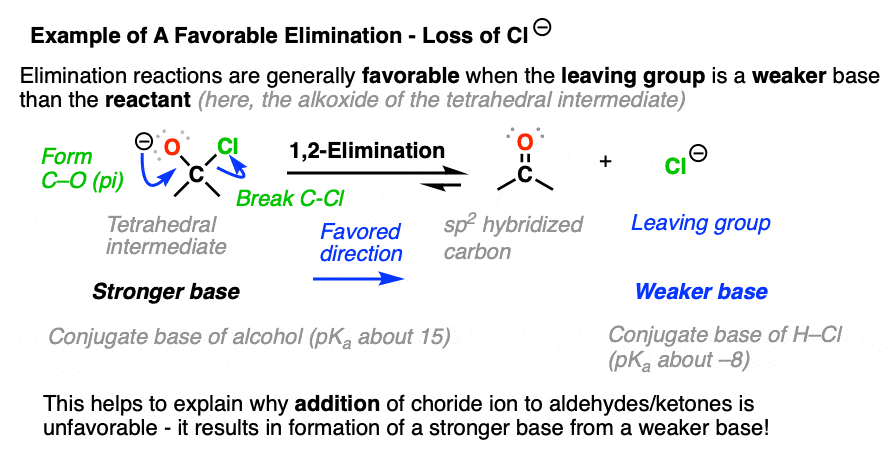
Elimination is unfavorable when it results in a stronger base being formed from a weaker base. This is why reduction of aldehydes and ketones with hydride reducing agents like NaBH4 is irreversible (See: Sodium Borohydride).
The forward reaction for hydride reduction of aldehydes and ketones results in a stronger base (hydride, conjugate base of H2, pKa about 35) being converted to a weaker base (alkoxide, conjugate base of alcohol, pKa about 16-18).
The opposite reaction (elimination) is about 20 pKa units more disfavored from an acid-base perspective (See post: How to Use a pKa Table)
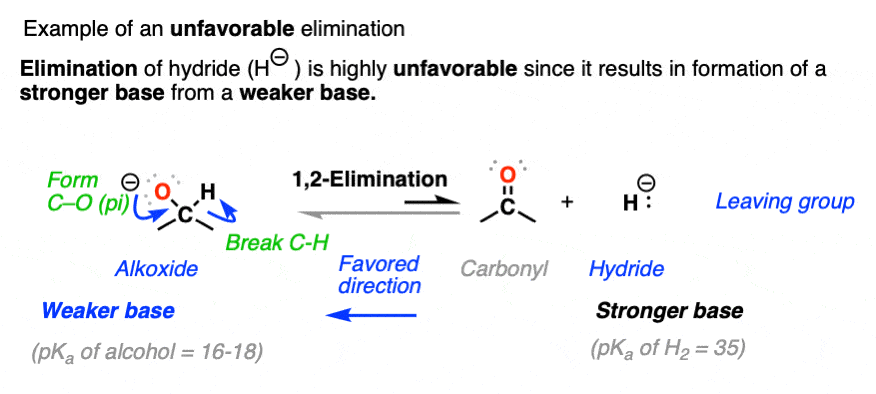
In general, a good rule of thumb is that if the nucleophile/base and leaving group are separated by more than 8 pKa units, the reaction can be considered to be irreversible. (See: A Handy Rule of Thumb For Acid-Base Reactions)
(However, there are some examples of reactions where H(-) can act as a leaving group in a concerted process – See Note 1)
The Principle of Acid-Base Mediocrity (“stronger acid plus stronger base gives weaker acid plus weaker base) keeps coming up again and again!
2. Elimination In Carboxylic Acid Derivatives
Besides aldehydes and ketones, addition and elimination also occur in the reactions of carboxylic acid derivatives such as acid halides, acid anhydrides, esters, and amides.
When nucleophilic addition occurs to a carboxylic acid derivative, it forms a tetrahedral intermediate with two potential leaving groups. [ but not the O- Note 2]
- The first potential leaving group is the original nucleophile; elimination of this from the tetrahedral intermediate would just give us back our starting material (after all, leaving groups are really just nucleophiles acting in reverse).
- The other potential leaving group is the X of the carboxylic acid derivative (e.g. (–)Cl for acid chlorides, (–)OCOR for anhydrides, (–)OR for esters, (–)NR2 , (–NHR), –(NH2) for amides)
When the nucleophile is a stronger base than the leaving group X(-) of the carboxylic acid derivative, then we will end up swapping out the X group of the carboxylic acid derivative. This is nucleophilic acyl substitution. (See post: Nucleophilic Acyl Substitution With Anionic Nucleophiles)
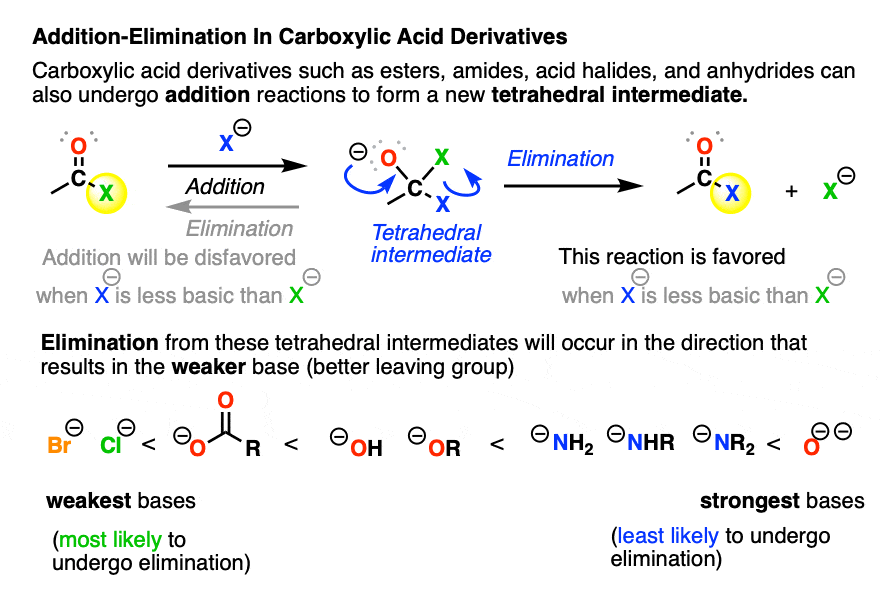
With negatively charged nucleophiles, nucleophilic acyl substitution is easy to perform on acid halides and acid anhydrides, more difficult to perform on esters, and essentially impossible to achieve with amides, since that would require loss of the very basic leaving group NH2(-), conjugate base of an amine (pKa 35-38)
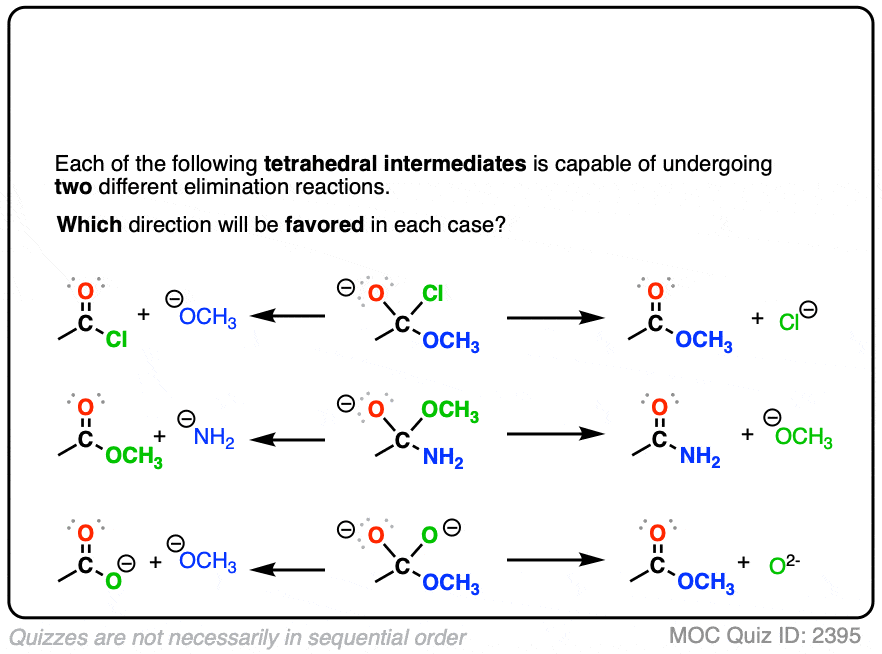 Click to Flip
Click to Flip
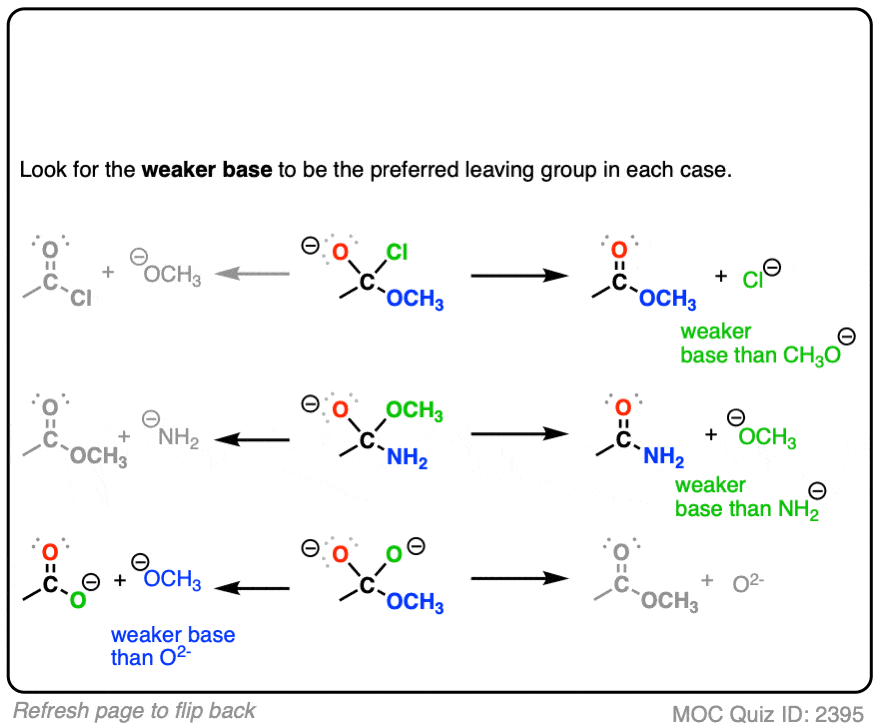
Carboxylic acids generally don’t undergo addition-elimination under basic conditions since they will be deprotonated by strong base to give carboxylates, and the resulting leaving group would have to be the very strong base O(2-) (covered in more detail in this post: Transesterification)
3. What About Neutral Nucleophiles?
It’s not absolutely required to use basic nucleophiles for nucleophilic aromatic substitution, however.
Neutral nucleophiles are perfectly capable of performing some nucleophilic acyl substitutions.
One prominent case is that of acid halides and anhydrides, which are very sensitive to the presence of water.
Both of these functional groups can be hydrolyzed with water to give carboxylic acids.
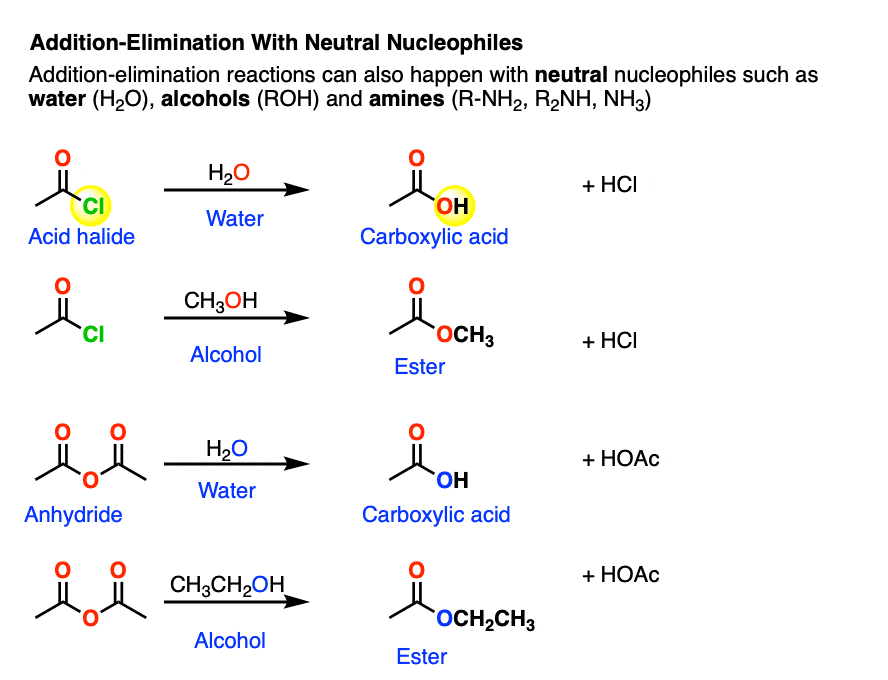
After addition and proton transfer, the key step is elimination of the halide ion, resulting in formation of the carboxylic acid. This still follows the Principle of Acid-Base Mediocrity, since Cl(-) is a weaker base than H2O (conjugate base of H3O+, pKa 0) . Likewise, water is at least comparable in base strength to carboxylic acids.
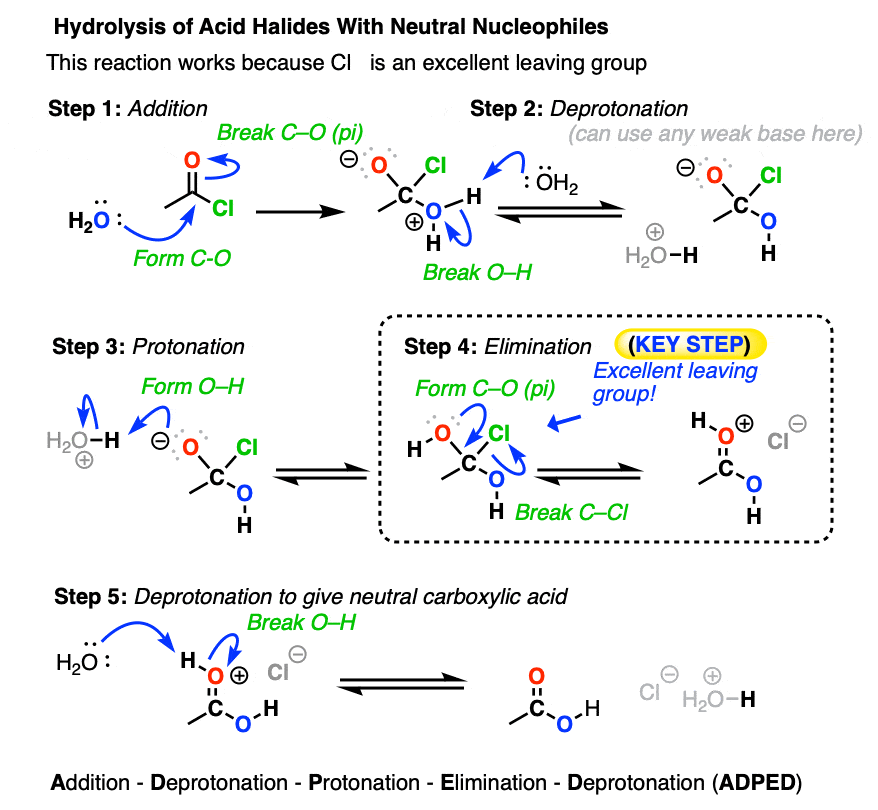
To see a mechanism for hydrolysis of acid anhydrides with water, hover here or click this link.
These reactions also work well with amines. The reactions between acid halides and amines are some of the best ways for making amides; this reaction is sometimes known as the Schotten-Baumann reaction (See Synthesis of Amides From Acid Halides).
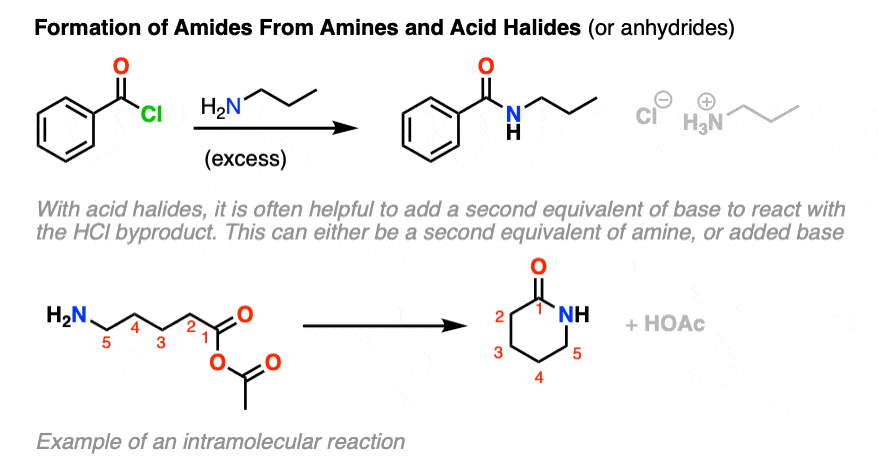
Generally, at least two equivalents of amine are used, since one equivalent of HCl is generated. (If only one equivalent of amine were used, the reaction would not proceed to completion since the amine nucleophile would be protonated to give (non-nucleophilic) RNH3(+). )
To see a mechanism for the formation of amides from acid halides, hover here or click this link.
4. Acidic Conditions – Elimination Of The Conjugate Acid (A Better Leaving Group)
Addition of neutral nucleophiles to carboxylic acids has its limits, however. Water can displace weakly basic halides and carboxylates, but can’t displace the much stronger bases RO(-) or R2N(-). (Amines, if heated might displace esters, but it requires a lot of heat – See Synthesis of Amides).
Aside from acid halides and anhydrides, most other carboxylic acids are inert under neutral conditions.
However, when an acid catalyst is added, it’s a different story altogether. It opens up a whole different set of reactions that don’t happen otherwise.
We’ve previously seen an example of this in the synthesis of acetals (See post: Acetals and Hemiacetals) where elimination of one equivalent of ROH from a hemiacetal required an acid catalyst. (In the absence of acid, no elimination happens!).
For a reminder of the elimination mechanism in acetal synthesis, hover here or click this link.
This is also the case for carboxylic acid derivatives.
Recall that the whole reason amides and carboxylic acids are unreactive under basic and neutral conditions is because NH2(-) and O(-) are such strong bases and therefore poor leaving groups.
But just imagine for a moment that we could run these reactions under acidic conditions.
Their leaving groups would no longer be NH2(–) and O(2-) ; they could be their protonated cousins NH3 and H2O , which are much weaker bases and therefore much better leaving groups.
Suddenly, substitution reactions of carboxylic acids and esters becomes a plausible reaction!
Compare the leaving groups in these two reactions
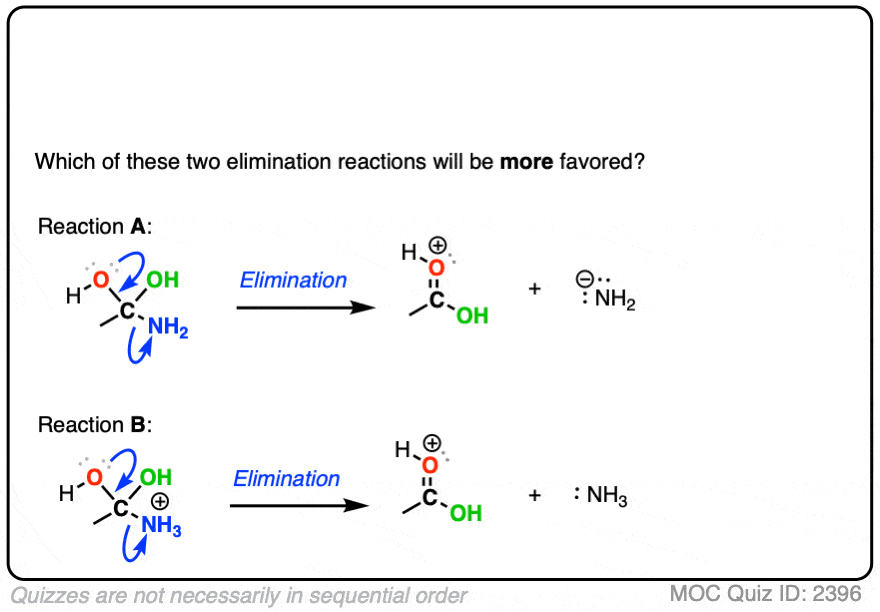 Click to Flip
Click to Flip
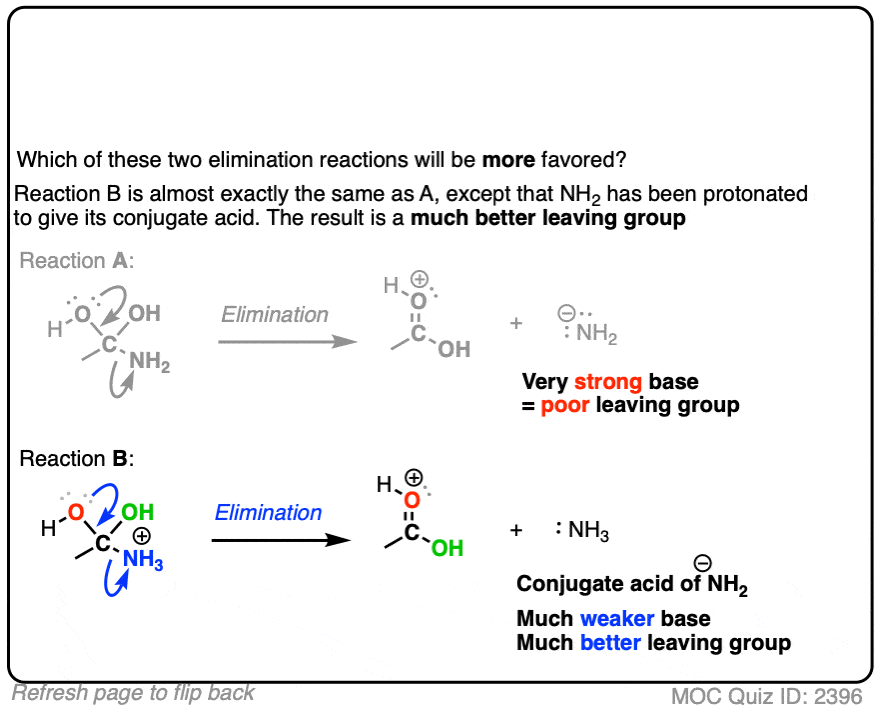
Or the leaving groups in these two reactions
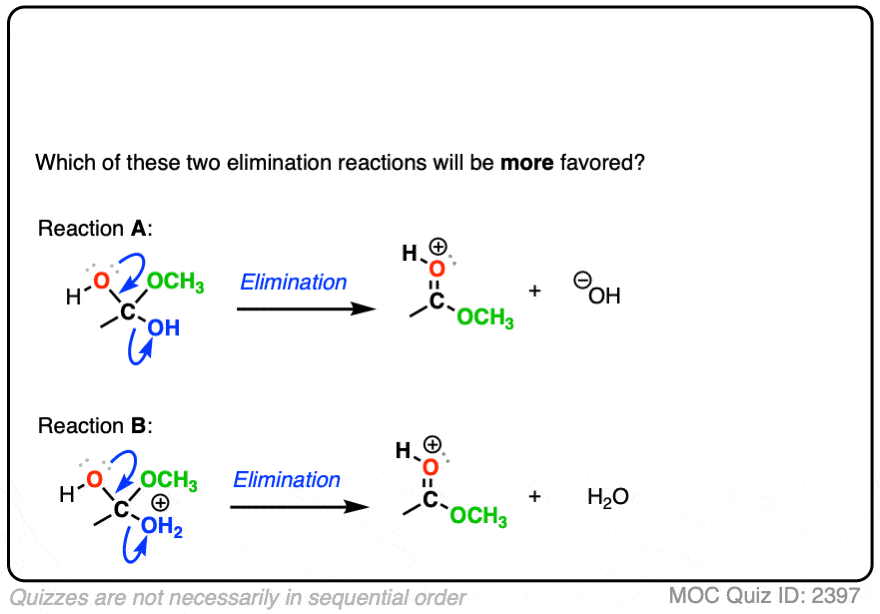 Click to Flip
Click to Flip
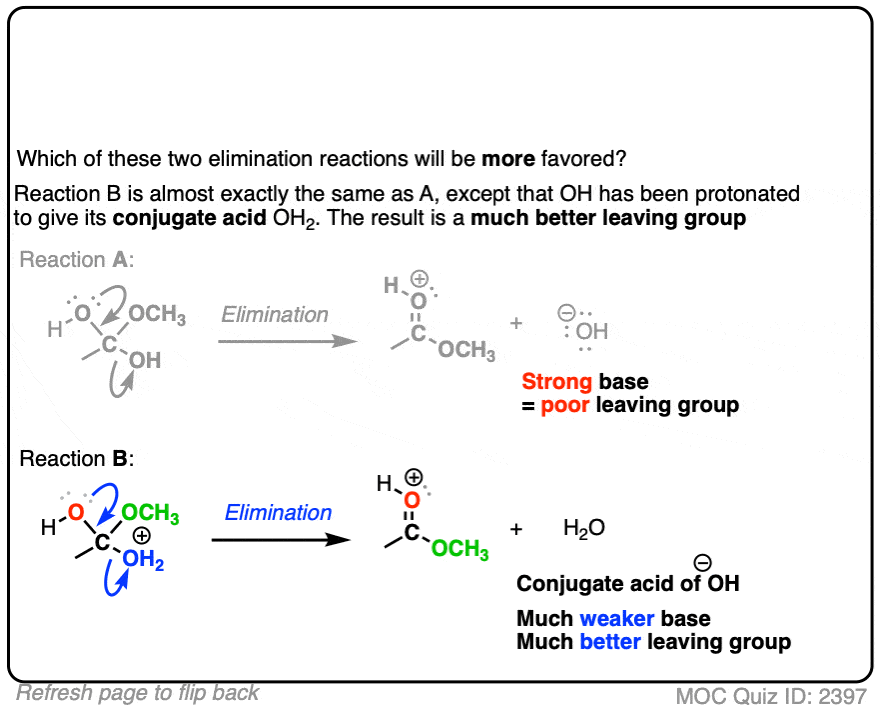
In each case, the protonated species is the better leaving group, because it is the weaker base.
The conjugate acid is a better leaving group, which is one important reason why acid catalysis helps with elimination reactions.
5. Examples Of Acid Catalysis In Nucleophilic Acyl Substitution
Here are two examples of using acid as a catalyst in nucleophilic acyl substitution reactions, and how acid assists with loss of a leaving group.
A carboxylic acid can be converted into an ester under acidic conditions. This is the Fischer Esterification (See post: Fischer Esterification).
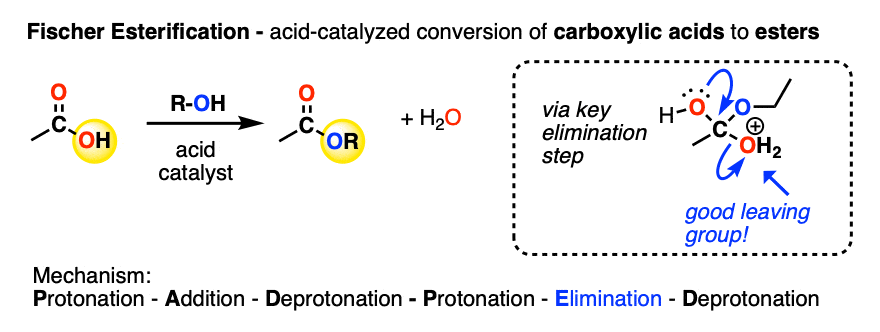
In the key step, a molecule of H2O is eliminated from the tetrahedral intermediate, resulting in a protonated ester.
Similarly, amides can be converted to a carboxylic acid under acidic conditions. This is called acidic amide hydrolysis (See post: Amide Hydrolysis)
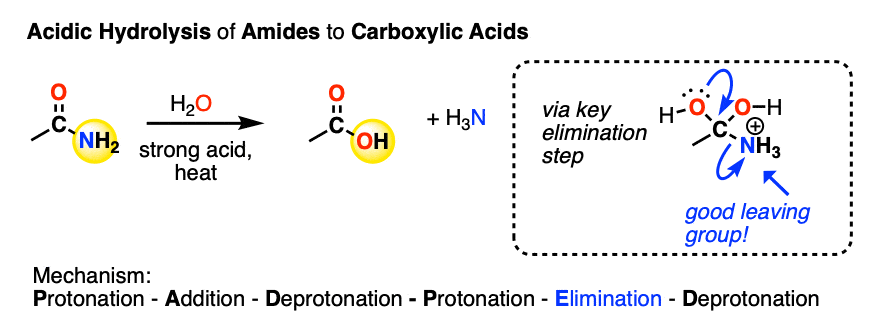
Likewise, the key step is elimination of the weak base NH3 from the tetrahedral intermediate. In the absence of acid, no substitution occurs.
One limitation of acid catalysis for elimination is that we’re limited to using nucleophiles that aren’t irreversibly destroyed by strong acid.
This means that strongly basic nucleophiles like NH2(-), HO(-), RO(-), hydrides and Grignards are incompatible with acidic conditions, since acid-bases reactions are generally much faster than any reactions at carbon. (See post: Acid-Base Reactions are Fast),
6. Summary – Conclusion
- If nucleophilic addition is the most important reaction mechanism of carbonyls, then its opposite – elimination – ranks as the second-most important mechanism.
- It’s a key mechanism in nucleophilic acyl substitution reactions, in addition to its role in formation of acetals and imines that we saw previously in the chapter on aldehydes and ketones.
- The favorability of elimination is determined by the basicity of the leaving group. Good leaving groups are weak bases.
- Poor leaving groups can be transformed into good leaving groups through the addition of acid, since the conjugate acid of any species is a weaker base and therefore a better leaving group.
- Addition of acid is essential in the nucleophilic substitution reactions of carboxylic acids and amides such as the Fischer esterification and acidic amide hydrolysis.
Notes
Related Articles
- Nucleophilic Addition To Carbonyls
- Transesterification
- Fischer Esterification – Carboxylic Acid to Ester Under Acidic Conditions
- Amide Hydrolysis
- Nucleophilic Acyl Substitution (With Negatively Charged Nucleophiles)
- What makes a good leaving group?
- How to Use a pKa Table
- Proton Transfer
- The Amide Functional Group: Properties, Synthesis, and Nomenclature
- Thionyl Chloride (SOCl2)
Note 1. One example where hydride does leave in an elimination-type process is in the Canizarro reaction of aldehydes. The key step is transfer of a hydride from a (deprotonated) aldehyde hemiacetal to a second equivalent of the same aldehyde, resulting in an alkoxide and a carboxylic acid (which quickly undergo an acid-base reaction).

However, this reaction requires extremely basic conditions and heat (as well as requiring non-enolizable aldehydes)
Note 2. But not O- , since this would have to leave as O2-
Quiz Yourself!
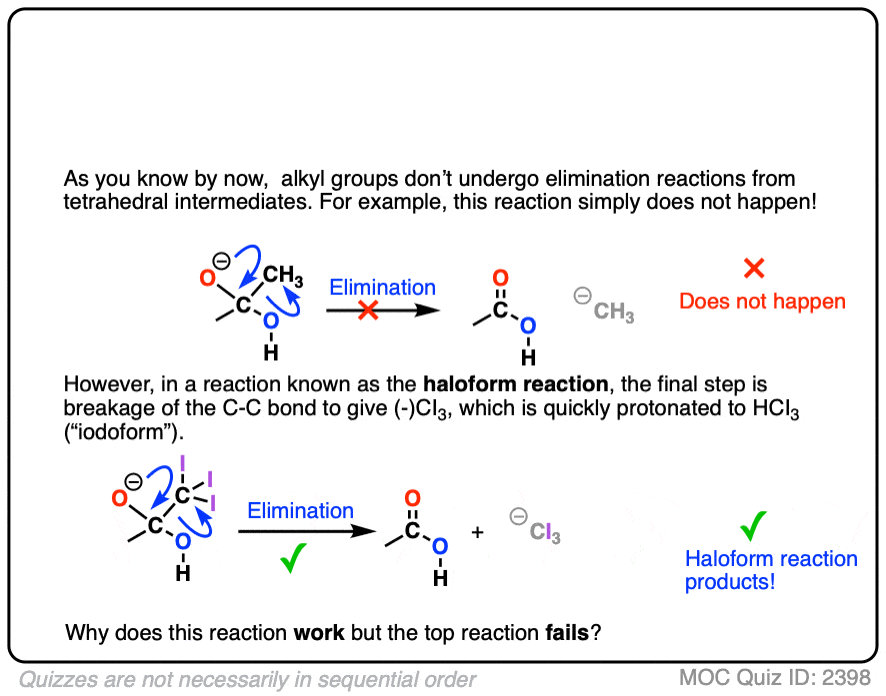 Click to Flip
Click to Flip
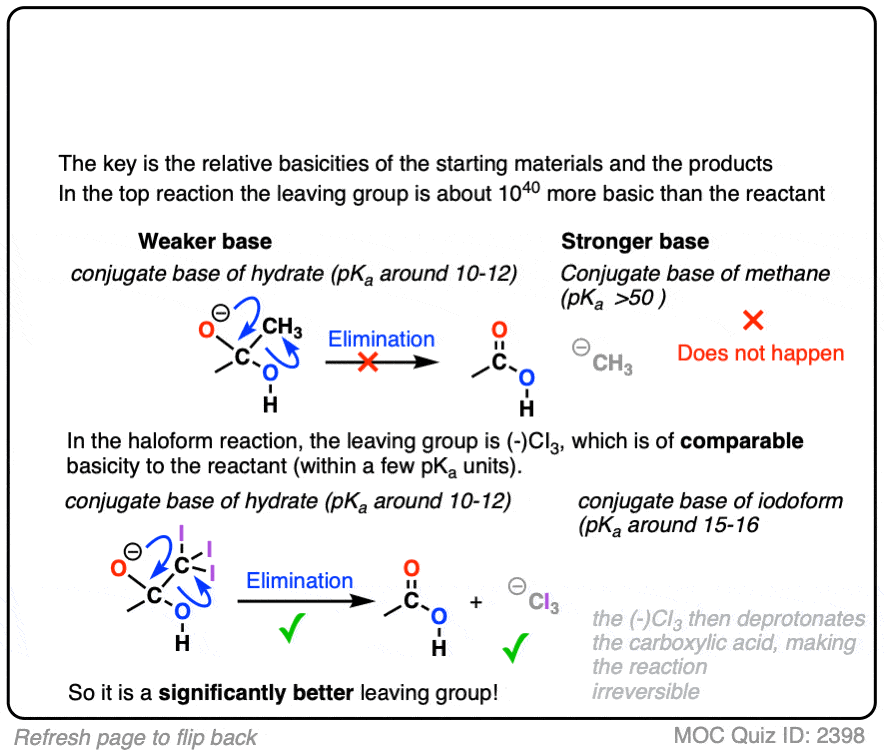
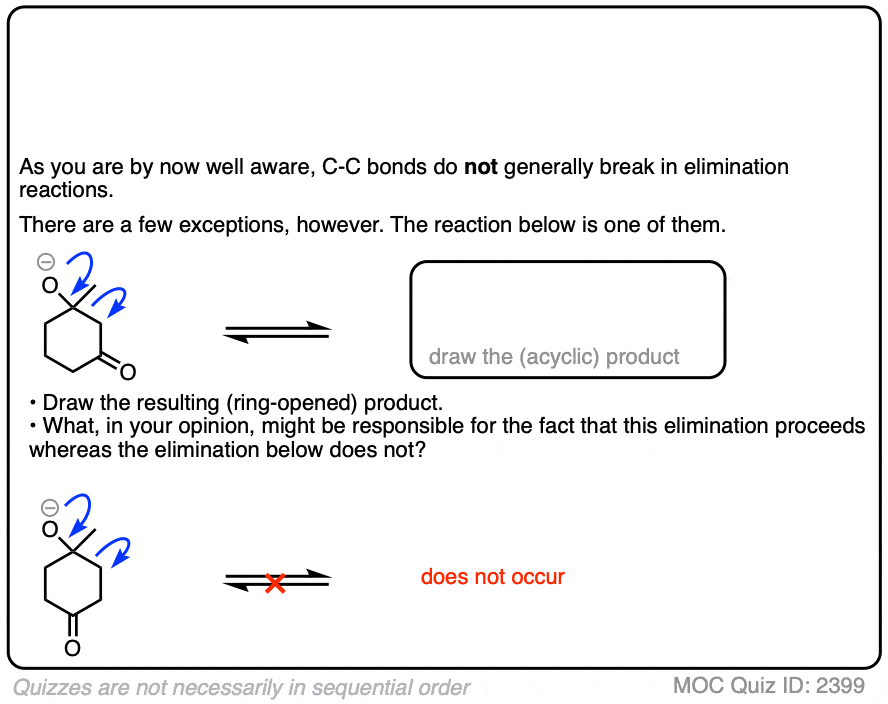 Click to Flip
Click to Flip
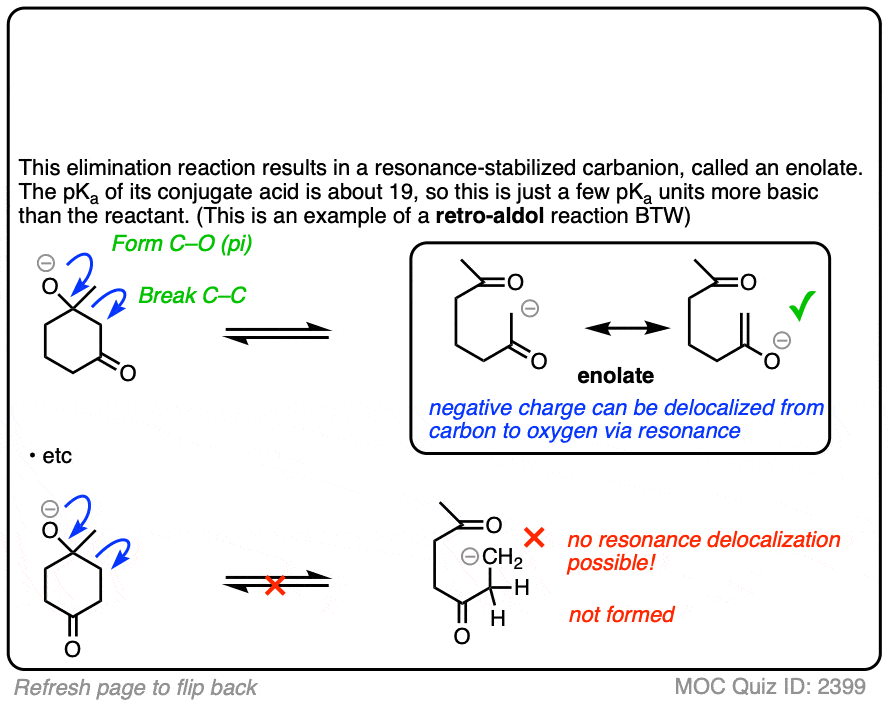
(Advanced) References and Further Reading
- SN2 Mechanism for Alcoholysis, Aminolysis, and Hydrolysis of Acetyl Chloride
T. William Bentley, Gareth Llewellyn, and J. Anthony McAlister
The Journal of Organic Chemistry 1996 61 (22), 7927-7932
DOI: 10.1021/jo9609844
Although addition-elimination reactions are assumed in most cases, there are situations where nucleophilic acyl substitution results from direct attack at a carbonyl carbon with a nucleophile, especially in highly polar solvents where the leaving group is easily ionized. - Computational Studies of Nucleophilic Substitution at Carbonyl Carbon: the SN2 Mechanism versus the Tetrahedral Intermediate in Organic Synthesis
Joseph M. Fox, Olga Dmitrenko, Lian-an Liao, and Robert D. Bach
The Journal of Organic Chemistry 2004 69 (21), 7317-7328
DOI: 10.1021/jo049494z - Estimates of hydride ion stability in condensed systems: energy of formation and solvation in aqueous and polar-organic solvents
Craig A. Kelly and David R. Rosseinsky
Phys. Chem. Chem. Phys., 2001 ,3, 2086-2090
DOI: 10.1039/B010092G
Source of the pKa of H2 as 35 (in DMSO)Formation of amides from acid halides (and anhydrides) - BENZOYL PIPERIDINE
Marvel, C. S.; Lazier, W. A.
Org. Synth. 1929, 9, 16
DOI: 10.15227/orgsyn.009.0016
This procedure from Organic Syntheses, a source of independently tested and reproducible synthetic organic laboratory procedures, is a classic Schotten-Baumann amide synthesis.The original Schotten-Baumann papers: - Ueber die Oxydation des Piperidins
Schotten, C.
Ber. 1884, 17 (2), 2544-2547
DOI: 10.1002/cber.188401702178 - Ueber eine einfache Methode der Darstellung von Benzoësäureäthern
Baumann, E.
Ber. 1886, 19 (2), 3218-3222
DOI: 10.1002/cber.188601902348
00 General Chemistry Review
01 Bonding, Structure, and Resonance
- How Do We Know Methane (CH4) Is Tetrahedral?
- Hybrid Orbitals and Hybridization
- How To Determine Hybridization: A Shortcut
- Orbital Hybridization And Bond Strengths
- Sigma bonds come in six varieties: Pi bonds come in one
- A Key Skill: How to Calculate Formal Charge
- The Four Intermolecular Forces and How They Affect Boiling Points
- 3 Trends That Affect Boiling Points
- How To Use Electronegativity To Determine Electron Density (and why NOT to trust formal charge)
- Introduction to Resonance
- How To Use Curved Arrows To Interchange Resonance Forms
- Evaluating Resonance Forms (1) - The Rule of Least Charges
- How To Find The Best Resonance Structure By Applying Electronegativity
- Evaluating Resonance Structures With Negative Charges
- Evaluating Resonance Structures With Positive Charge
- Exploring Resonance: Pi-Donation
- Exploring Resonance: Pi-acceptors
- In Summary: Evaluating Resonance Structures
- Drawing Resonance Structures: 3 Common Mistakes To Avoid
- How to apply electronegativity and resonance to understand reactivity
- Bond Hybridization Practice
- Structure and Bonding Practice Quizzes
- Resonance Structures Practice
02 Acid Base Reactions
- Introduction to Acid-Base Reactions
- Acid Base Reactions In Organic Chemistry
- The Stronger The Acid, The Weaker The Conjugate Base
- Walkthrough of Acid-Base Reactions (3) - Acidity Trends
- Five Key Factors That Influence Acidity
- Acid-Base Reactions: Introducing Ka and pKa
- How to Use a pKa Table
- The pKa Table Is Your Friend
- A Handy Rule of Thumb for Acid-Base Reactions
- Acid Base Reactions Are Fast
- pKa Values Span 60 Orders Of Magnitude
- How Protonation and Deprotonation Affect Reactivity
- Acid Base Practice Problems
03 Alkanes and Nomenclature
- Meet the (Most Important) Functional Groups
- Condensed Formulas: Deciphering What the Brackets Mean
- Hidden Hydrogens, Hidden Lone Pairs, Hidden Counterions
- Don't Be Futyl, Learn The Butyls
- Primary, Secondary, Tertiary, Quaternary In Organic Chemistry
- Branching, and Its Affect On Melting and Boiling Points
- The Many, Many Ways of Drawing Butane
- Wedge And Dash Convention For Tetrahedral Carbon
- Common Mistakes in Organic Chemistry: Pentavalent Carbon
- Table of Functional Group Priorities for Nomenclature
- Summary Sheet - Alkane Nomenclature
- Organic Chemistry IUPAC Nomenclature Demystified With A Simple Puzzle Piece Approach
- Boiling Point Quizzes
- Organic Chemistry Nomenclature Quizzes
04 Conformations and Cycloalkanes
- Staggered vs Eclipsed Conformations of Ethane
- Conformational Isomers of Propane
- Newman Projection of Butane (and Gauche Conformation)
- Introduction to Cycloalkanes
- Geometric Isomers In Small Rings: Cis And Trans Cycloalkanes
- Calculation of Ring Strain In Cycloalkanes
- Cycloalkanes - Ring Strain In Cyclopropane And Cyclobutane
- Cyclohexane Conformations
- Cyclohexane Chair Conformation: An Aerial Tour
- How To Draw The Cyclohexane Chair Conformation
- The Cyclohexane Chair Flip
- The Cyclohexane Chair Flip - Energy Diagram
- Substituted Cyclohexanes - Axial vs Equatorial
- Ranking The Bulkiness Of Substituents On Cyclohexanes: "A-Values"
- Cyclohexane Chair Conformation Stability: Which One Is Lower Energy?
- Fused Rings - Cis-Decalin and Trans-Decalin
- Naming Bicyclic Compounds - Fused, Bridged, and Spiro
- Bredt's Rule (And Summary of Cycloalkanes)
- Newman Projection Practice
- Cycloalkanes Practice Problems
05 A Primer On Organic Reactions
- The Most Important Question To Ask When Learning a New Reaction
- Curved Arrows (for reactions)
- Nucleophiles and Electrophiles
- The Three Classes of Nucleophiles
- Nucleophilicity vs. Basicity
- What Makes A Good Nucleophile?
- What Makes A Good Leaving Group?
- 3 Factors That Stabilize Carbocations
- Equilibrium and Energy Relationships
- 7 Factors that stabilize negative charge in organic chemistry
- 7 Factors That Stabilize Positive Charge in Organic Chemistry
- What's a Transition State?
- Hammond's Postulate
- Learning Organic Chemistry Reactions: A Checklist (PDF)
- Introduction to Oxidative Cleavage Reactions
06 Free Radical Reactions
- Free Radical Reactions
- 3 Factors That Stabilize Free Radicals
- Bond Strengths And Radical Stability
- Free Radical Initiation: Why Is "Light" Or "Heat" Required?
- Initiation, Propagation, Termination
- Monochlorination Products Of Propane, Pentane, And Other Alkanes
- Selectivity In Free Radical Reactions
- Selectivity in Free Radical Reactions: Bromination vs. Chlorination
- Halogenation At Tiffany's
- Allylic Bromination
- Bonus Topic: Allylic Rearrangements
- In Summary: Free Radicals
- Synthesis (2) - Reactions of Alkanes
- Free Radicals Practice Quizzes
07 Stereochemistry and Chirality
- Types of Isomers: Constitutional Isomers, Stereoisomers, Enantiomers, and Diastereomers
- How To Draw The Enantiomer Of A Chiral Molecule
- How To Draw A Bond Rotation
- Introduction to Assigning (R) and (S): The Cahn-Ingold-Prelog Rules
- Assigning Cahn-Ingold-Prelog (CIP) Priorities (2) - The Method of Dots
- Enantiomers vs Diastereomers vs The Same? Two Methods For Solving Problems
- Assigning R/S To Newman Projections (And Converting Newman To Line Diagrams)
- How To Determine R and S Configurations On A Fischer Projection
- The Meso Trap
- Optical Rotation, Optical Activity, and Specific Rotation
- Optical Purity and Enantiomeric Excess
- What's a Racemic Mixture?
- Chiral Allenes And Chiral Axes
- Stereochemistry Practice Problems and Quizzes
08 Substitution Reactions
- Nucleophilic Substitution Reactions - Introduction
- Two Types of Nucleophilic Substitution Reactions
- The SN2 Mechanism
- Why the SN2 Reaction Is Powerful
- The SN1 Mechanism
- The Conjugate Acid Is A Better Leaving Group
- Comparing the SN1 and SN2 Reactions
- Polar Protic? Polar Aprotic? Nonpolar? All About Solvents
- Steric Hindrance is Like a Fat Goalie
- Common Blind Spot: Intramolecular Reactions
- Substitution Practice - SN1
- Substitution Practice - SN2
09 Elimination Reactions
- Elimination Reactions (1): Introduction And The Key Pattern
- Elimination Reactions (2): The Zaitsev Rule
- Elimination Reactions Are Favored By Heat
- Two Elimination Reaction Patterns
- The E1 Reaction
- The E2 Mechanism
- E1 vs E2: Comparing the E1 and E2 Reactions
- Antiperiplanar Relationships: The E2 Reaction and Cyclohexane Rings
- Bulky Bases in Elimination Reactions
- Comparing the E1 vs SN1 Reactions
- Elimination (E1) Reactions With Rearrangements
- E1cB - Elimination (Unimolecular) Conjugate Base
- Elimination (E1) Practice Problems And Solutions
- Elimination (E2) Practice Problems and Solutions
10 Rearrangements
11 SN1/SN2/E1/E2 Decision
- Identifying Where Substitution and Elimination Reactions Happen
- Deciding SN1/SN2/E1/E2 (1) - The Substrate
- Deciding SN1/SN2/E1/E2 (2) - The Nucleophile/Base
- SN1 vs E1 and SN2 vs E2 : The Temperature
- Deciding SN1/SN2/E1/E2 - The Solvent
- Wrapup: The Key Factors For Determining SN1/SN2/E1/E2
- Alkyl Halide Reaction Map And Summary
- SN1 SN2 E1 E2 Practice Problems
12 Alkene Reactions
- E and Z Notation For Alkenes (+ Cis/Trans)
- Alkene Stability
- Alkene Addition Reactions: "Regioselectivity" and "Stereoselectivity" (Syn/Anti)
- Stereoselective and Stereospecific Reactions
- Hydrohalogenation of Alkenes and Markovnikov's Rule
- Hydration of Alkenes With Aqueous Acid
- Rearrangements in Alkene Addition Reactions
- Halogenation of Alkenes and Halohydrin Formation
- Oxymercuration Demercuration of Alkenes
- Hydroboration Oxidation of Alkenes
- m-CPBA (meta-chloroperoxybenzoic acid)
- OsO4 (Osmium Tetroxide) for Dihydroxylation of Alkenes
- Palladium on Carbon (Pd/C) for Catalytic Hydrogenation of Alkenes
- Cyclopropanation of Alkenes
- A Fourth Alkene Addition Pattern - Free Radical Addition
- Alkene Reactions: Ozonolysis
- Summary: Three Key Families Of Alkene Reaction Mechanisms
- Synthesis (4) - Alkene Reaction Map, Including Alkyl Halide Reactions
- Alkene Reactions Practice Problems
13 Alkyne Reactions
- Acetylides from Alkynes, And Substitution Reactions of Acetylides
- Partial Reduction of Alkynes With Lindlar's Catalyst
- Partial Reduction of Alkynes With Na/NH3 To Obtain Trans Alkenes
- Alkyne Hydroboration With "R2BH"
- Hydration and Oxymercuration of Alkynes
- Hydrohalogenation of Alkynes
- Alkyne Halogenation: Bromination and Chlorination of Alkynes
- Oxidation of Alkynes With O3 and KMnO4
- Alkenes To Alkynes Via Halogenation And Elimination Reactions
- Alkynes Are A Blank Canvas
- Synthesis (5) - Reactions of Alkynes
- Alkyne Reactions Practice Problems With Answers
14 Alcohols, Epoxides and Ethers
- Alcohols - Nomenclature and Properties
- Alcohols Can Act As Acids Or Bases (And Why It Matters)
- Alcohols - Acidity and Basicity
- The Williamson Ether Synthesis
- Ethers From Alkenes, Tertiary Alkyl Halides and Alkoxymercuration
- Alcohols To Ethers via Acid Catalysis
- Cleavage Of Ethers With Acid
- Epoxides - The Outlier Of The Ether Family
- Opening of Epoxides With Acid
- Epoxide Ring Opening With Base
- Making Alkyl Halides From Alcohols
- Tosylates And Mesylates
- PBr3 and SOCl2
- Elimination Reactions of Alcohols
- Elimination of Alcohols To Alkenes With POCl3
- Alcohol Oxidation: "Strong" and "Weak" Oxidants
- Demystifying The Mechanisms of Alcohol Oxidations
- Protecting Groups For Alcohols
- Thiols And Thioethers
- Calculating the oxidation state of a carbon
- Oxidation and Reduction in Organic Chemistry
- Oxidation Ladders
- SOCl2 Mechanism For Alcohols To Alkyl Halides: SN2 versus SNi
- Alcohol Reactions Roadmap (PDF)
- Alcohol Reaction Practice Problems
- Epoxide Reaction Quizzes
- Oxidation and Reduction Practice Quizzes
15 Organometallics
- What's An Organometallic?
- Formation of Grignard and Organolithium Reagents
- Organometallics Are Strong Bases
- Reactions of Grignard Reagents
- Protecting Groups In Grignard Reactions
- Synthesis Problems Involving Grignard Reagents
- Grignard Reactions And Synthesis (2)
- Organocuprates (Gilman Reagents): How They're Made
- Gilman Reagents (Organocuprates): What They're Used For
- The Heck, Suzuki, and Olefin Metathesis Reactions (And Why They Don't Belong In Most Introductory Organic Chemistry Courses)
- Reaction Map: Reactions of Organometallics
- Grignard Practice Problems
16 Spectroscopy
- Degrees of Unsaturation (or IHD, Index of Hydrogen Deficiency)
- Conjugation And Color (+ How Bleach Works)
- Introduction To UV-Vis Spectroscopy
- UV-Vis Spectroscopy: Absorbance of Carbonyls
- UV-Vis Spectroscopy: Practice Questions
- Bond Vibrations, Infrared Spectroscopy, and the "Ball and Spring" Model
- Infrared Spectroscopy: A Quick Primer On Interpreting Spectra
- IR Spectroscopy: 4 Practice Problems
- 1H NMR: How Many Signals?
- Homotopic, Enantiotopic, Diastereotopic
- Diastereotopic Protons in 1H NMR Spectroscopy: Examples
- 13-C NMR - How Many Signals
- Liquid Gold: Pheromones In Doe Urine
- Natural Product Isolation (1) - Extraction
- Natural Product Isolation (2) - Purification Techniques, An Overview
- Structure Determination Case Study: Deer Tarsal Gland Pheromone
17 Dienes and MO Theory
- What To Expect In Organic Chemistry 2
- Are these molecules conjugated?
- Conjugation And Resonance In Organic Chemistry
- Bonding And Antibonding Pi Orbitals
- Molecular Orbitals of The Allyl Cation, Allyl Radical, and Allyl Anion
- Pi Molecular Orbitals of Butadiene
- Reactions of Dienes: 1,2 and 1,4 Addition
- Thermodynamic and Kinetic Products
- More On 1,2 and 1,4 Additions To Dienes
- s-cis and s-trans
- The Diels-Alder Reaction
- Cyclic Dienes and Dienophiles in the Diels-Alder Reaction
- Stereochemistry of the Diels-Alder Reaction
- Exo vs Endo Products In The Diels Alder: How To Tell Them Apart
- HOMO and LUMO In the Diels Alder Reaction
- Why Are Endo vs Exo Products Favored in the Diels-Alder Reaction?
- Diels-Alder Reaction: Kinetic and Thermodynamic Control
- The Retro Diels-Alder Reaction
- The Intramolecular Diels Alder Reaction
- Regiochemistry In The Diels-Alder Reaction
- The Cope and Claisen Rearrangements
- Electrocyclic Reactions
- Electrocyclic Ring Opening And Closure (2) - Six (or Eight) Pi Electrons
- Diels Alder Practice Problems
- Molecular Orbital Theory Practice
18 Aromaticity
- Introduction To Aromaticity
- Rules For Aromaticity
- Huckel's Rule: What Does 4n+2 Mean?
- Aromatic, Non-Aromatic, or Antiaromatic? Some Practice Problems
- Antiaromatic Compounds and Antiaromaticity
- The Pi Molecular Orbitals of Benzene
- The Pi Molecular Orbitals of Cyclobutadiene
- Frost Circles
- Aromaticity Practice Quizzes
19 Reactions of Aromatic Molecules
- Electrophilic Aromatic Substitution: Introduction
- Activating and Deactivating Groups In Electrophilic Aromatic Substitution
- Electrophilic Aromatic Substitution - The Mechanism
- Ortho-, Para- and Meta- Directors in Electrophilic Aromatic Substitution
- Understanding Ortho, Para, and Meta Directors
- Why are halogens ortho- para- directors?
- Disubstituted Benzenes: The Strongest Electron-Donor "Wins"
- Electrophilic Aromatic Substitutions (1) - Halogenation of Benzene
- Electrophilic Aromatic Substitutions (2) - Nitration and Sulfonation
- EAS Reactions (3) - Friedel-Crafts Acylation and Friedel-Crafts Alkylation
- Intramolecular Friedel-Crafts Reactions
- Nucleophilic Aromatic Substitution (NAS)
- Nucleophilic Aromatic Substitution (2) - The Benzyne Mechanism
- Reactions on the "Benzylic" Carbon: Bromination And Oxidation
- The Wolff-Kishner, Clemmensen, And Other Carbonyl Reductions
- More Reactions on the Aromatic Sidechain: Reduction of Nitro Groups and the Baeyer Villiger
- Aromatic Synthesis (1) - "Order Of Operations"
- Synthesis of Benzene Derivatives (2) - Polarity Reversal
- Aromatic Synthesis (3) - Sulfonyl Blocking Groups
- Birch Reduction
- Synthesis (7): Reaction Map of Benzene and Related Aromatic Compounds
- Aromatic Reactions and Synthesis Practice
- Electrophilic Aromatic Substitution Practice Problems
20 Aldehydes and Ketones
- What's The Alpha Carbon In Carbonyl Compounds?
- Nucleophilic Addition To Carbonyls
- Aldehydes and Ketones: 14 Reactions With The Same Mechanism
- Sodium Borohydride (NaBH4) Reduction of Aldehydes and Ketones
- Grignard Reagents For Addition To Aldehydes and Ketones
- Wittig Reaction
- Hydrates, Hemiacetals, and Acetals
- Imines - Properties, Formation, Reactions, and Mechanisms
- All About Enamines
- Breaking Down Carbonyl Reaction Mechanisms: Reactions of Anionic Nucleophiles (Part 2)
- Aldehydes Ketones Reaction Practice
21 Carboxylic Acid Derivatives
- Nucleophilic Acyl Substitution (With Negatively Charged Nucleophiles)
- Addition-Elimination Mechanisms With Neutral Nucleophiles (Including Acid Catalysis)
- Basic Hydrolysis of Esters - Saponification
- Transesterification
- Proton Transfer
- Fischer Esterification - Carboxylic Acid to Ester Under Acidic Conditions
- Lithium Aluminum Hydride (LiAlH4) For Reduction of Carboxylic Acid Derivatives
- LiAlH[Ot-Bu]3 For The Reduction of Acid Halides To Aldehydes
- Di-isobutyl Aluminum Hydride (DIBAL) For The Partial Reduction of Esters and Nitriles
- Amide Hydrolysis
- Thionyl Chloride (SOCl2) And Conversion of Carboxylic Acids to Acid Halides
- Diazomethane (CH2N2)
- Carbonyl Chemistry: Learn Six Mechanisms For the Price Of One
- Making Music With Mechanisms (PADPED)
- Carboxylic Acid Derivatives Practice Questions
22 Enols and Enolates
- Keto-Enol Tautomerism
- Enolates - Formation, Stability, and Simple Reactions
- Kinetic Versus Thermodynamic Enolates
- Aldol Addition and Condensation Reactions
- Reactions of Enols - Acid-Catalyzed Aldol, Halogenation, and Mannich Reactions
- Claisen Condensation and Dieckmann Condensation
- Decarboxylation
- The Malonic Ester and Acetoacetic Ester Synthesis
- The Michael Addition Reaction and Conjugate Addition
- The Robinson Annulation
- Haloform Reaction
- The Hell–Volhard–Zelinsky Reaction
- Enols and Enolates Practice Quizzes
23 Amines
- The Amide Functional Group: Properties, Synthesis, and Nomenclature
- Basicity of Amines And pKaH
- 5 Key Basicity Trends of Amines
- The Mesomeric Effect And Aromatic Amines
- Nucleophilicity of Amines
- Alkylation of Amines (Sucks!)
- Reductive Amination
- The Gabriel Synthesis
- Some Reactions of Azides
- The Hofmann Elimination
- The Hofmann and Curtius Rearrangements
- The Cope Elimination
- Protecting Groups for Amines - Carbamates
- The Strecker Synthesis of Amino Acids
- Introduction to Peptide Synthesis
- Reactions of Diazonium Salts: Sandmeyer and Related Reactions
- Amine Practice Questions
24 Carbohydrates
- D and L Notation For Sugars
- Pyranoses and Furanoses: Ring-Chain Tautomerism In Sugars
- What is Mutarotation?
- Reducing Sugars
- The Big Damn Post Of Carbohydrate-Related Chemistry Definitions
- The Haworth Projection
- Converting a Fischer Projection To A Haworth (And Vice Versa)
- Reactions of Sugars: Glycosylation and Protection
- The Ruff Degradation and Kiliani-Fischer Synthesis
- Isoelectric Points of Amino Acids (and How To Calculate Them)
- Carbohydrates Practice
- Amino Acid Quizzes
25 Fun and Miscellaneous
- A Gallery of Some Interesting Molecules From Nature
- Screw Organic Chemistry, I'm Just Going To Write About Cats
- On Cats, Part 1: Conformations and Configurations
- On Cats, Part 2: Cat Line Diagrams
- On Cats, Part 4: Enantiocats
- On Cats, Part 6: Stereocenters
- Organic Chemistry Is Shit
- The Organic Chemistry Behind "The Pill"
- Maybe they should call them, "Formal Wins" ?
- Why Do Organic Chemists Use Kilocalories?
- The Principle of Least Effort
- Organic Chemistry GIFS - Resonance Forms
- Reproducibility In Organic Chemistry
- What Holds The Nucleus Together?
- How Reactions Are Like Music
- Organic Chemistry and the New MCAT
26 Organic Chemistry Tips and Tricks
- Common Mistakes: Formal Charges Can Mislead
- Partial Charges Give Clues About Electron Flow
- Draw The Ugly Version First
- Organic Chemistry Study Tips: Learn the Trends
- The 8 Types of Arrows In Organic Chemistry, Explained
- Top 10 Skills To Master Before An Organic Chemistry 2 Final
- Common Mistakes with Carbonyls: Carboxylic Acids... Are Acids!
- Planning Organic Synthesis With "Reaction Maps"
- Alkene Addition Pattern #1: The "Carbocation Pathway"
- Alkene Addition Pattern #2: The "Three-Membered Ring" Pathway
- Alkene Addition Pattern #3: The "Concerted" Pathway
- Number Your Carbons!
- The 4 Major Classes of Reactions in Org 1
- How (and why) electrons flow
- Grossman's Rule
- Three Exam Tips
- A 3-Step Method For Thinking Through Synthesis Problems
- Putting It Together
- Putting Diels-Alder Products in Perspective
- The Ups and Downs of Cyclohexanes
- The Most Annoying Exceptions in Org 1 (Part 1)
- The Most Annoying Exceptions in Org 1 (Part 2)
- The Marriage May Be Bad, But the Divorce Still Costs Money
- 9 Nomenclature Conventions To Know
- Nucleophile attacks Electrophile
27 Case Studies of Successful O-Chem Students
- Success Stories: How Corina Got The The "Hard" Professor - And Got An A+ Anyway
- How Helena Aced Organic Chemistry
- From a "Drop" To B+ in Org 2 – How A Hard Working Student Turned It Around
- How Serge Aced Organic Chemistry
- Success Stories: How Zach Aced Organic Chemistry 1
- Success Stories: How Kari Went From C– to B+
- How Esther Bounced Back From a "C" To Get A's In Organic Chemistry 1 And 2
- How Tyrell Got The Highest Grade In Her Organic Chemistry Course
- This Is Why Students Use Flashcards
- Success Stories: How Stu Aced Organic Chemistry
- How John Pulled Up His Organic Chemistry Exam Grades
- Success Stories: How Nathan Aced Organic Chemistry (Without It Taking Over His Life)
- How Chris Aced Org 1 and Org 2
- Interview: How Jay Got an A+ In Organic Chemistry
- How to Do Well in Organic Chemistry: One Student's Advice
- "America's Top TA" Shares His Secrets For Teaching O-Chem
- "Organic Chemistry Is Like..." - A Few Metaphors
- How To Do Well In Organic Chemistry: Advice From A Tutor
- Guest post: "I went from being afraid of tests to actually looking forward to them".
When aliphatic primary amines react with esters, for example, butylene diamine with dimethyl carbonate, the reaction rate is quite slow, but when water is added, it become very quick. How to explain this phenomenon?
Dimethyl carbonate is not an ester, it is a carbonate, which is a different functional group.
One of the key reactions of amines with carbonates is to install protective groups, such as the Boc group, and it is generally done under basic conditions (i.e. not just water, but water in the presence of a base such as sodium carbonate). Representative procedures can be found on this page:
https://www.organic-chemistry.org/protectivegroups/amino/boc-amino.htm
Would the haloform reaction which involves nucleophilic attack by OH followed by displacement of a CBr3 group also count?
Yes – great example. The Cl3C(-) anion leaves via a [1,2] elimination reaction.
“…(Halides, AcO(-),…”
What does AcO(-) mean?
Thanks!
AcO(-) means acetyl: CH3C(O)O- , the conjugate base of acetic acid